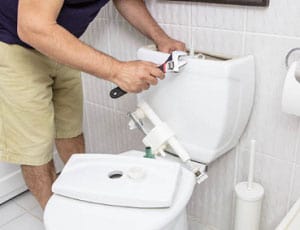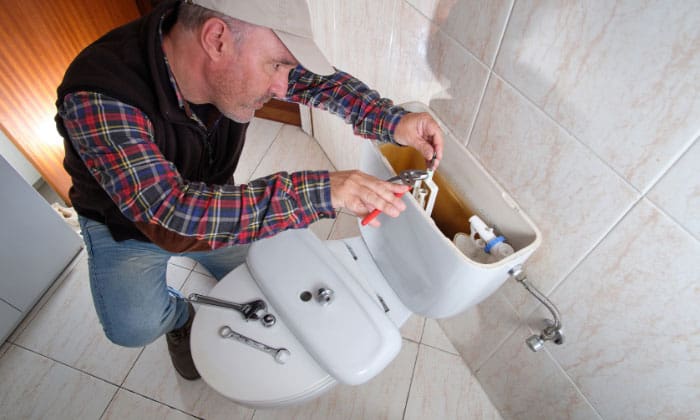How much does it cost to move a toilet? The exact answer depends on several factors. Aside from labor and/or contractor costs, unexpected expenses can impact the final price.
When you move a toilet in the UK or US, you need to tap into the existing waste line (ideal) or install a completely new one. Both are lengthy, labor-intensive, and – yes – costly processes that professionals should only handle. The same professionals can give you an exact quote for your toilet relocation.
But if you’d like a rough estimate and explanation for toilet rerouting pricing, keep reading.
Table of Contents
Average Cost to Move a Toilet
| PRICING FACTORS | PRICE RANGE |
| Total Drain Re-Routing Labor | $720 – $800 |
Includes:
|
|
| Re-Routing Supplies | $150 – $180 |
Includes:
|
|
| Equipment Allowance | $40 – $60 |
Includes:
|
|
| Labor Rates | $70/hour – $200/hour |
|
|
| Additional Costs | $150 – $1000 |
Includes:
|
|
| TOTAL POSSIBLE COSTS | $980 – $2,240 |
Cost to Reroute Toilet: The Price Breakdown
1. Types of Toilets
Technically speaking, you can move or re-route any type of toilet. The most common toilet is the Two-Piece toilet, where the water tank and bowl are separate. This model typically costs around $100 to $400.
Other types of toilets include Back-to-Wall toilets, One-Piece toilets, Wall-Hung toilets, and Low-Level toilets.
2. Types of Costs
There are four types of costs to consider when moving a toilet: (1) re-routing labor, (2) labor rates (typically paid per hour), (3) re-routing supplies, and (4) equipment allowance.
- Basic toilet drain re-routing labor
This is the biggest factor to remember when determining your budget to move a toilet. Reinstalling the toilet itself should take an hour or so. The truly labor-intensive – and therefore most costly – part of the process is re-routing the drainage and water supply lines.
Moving toilet plumbing – including parts like below-floor pipes, plumbing, electrical cables, insulation, etc. – can cost anywhere from $700 to upwards of $1,000. The further away the new location is from the original placement (and the more difficult it is to access), the higher the total price.
- Labor rates
Plumbers and/or contractors typically charge per hour. As of 2022, their average fee starts at $70 or $75 an hour. In some areas, a licensed plumber can charge as much as $200/hour for a complex project.
In theory, the cost of moving a toilet drain a little over 6 inches won’t differ significantly from the cost of moving the same toilet 3 feet. What’s going to drastically alter the labor cost is moving a toilet on an already existing sewer line versus having to install a new wastewater pipe and stack.
The latter is more complex – and will certainly take more time to complete – than the former, and the hourly rate will add up.
- Re-routing supplies
The cost of moving bathroom plumbing will include consumable supplies. Professional plumbers will bring the tools and equipment (and these have their own cost, too) needed for the re-routing process.
However, the customer is expected to pay for usable parts like mounting hardware, fittings, connectors, PVC or PEX pipes, and the like. Expect to pay around $150 to $300 for these, depending on their brand and quality.
- Equipment Allowance
As mentioned earlier, plumbers will bring their own installation and/or re-routing tools. These are rented daily and billed separately from the professional’s labor costs. They’ll total roughly $40 to $60 or so, depending on what was used. So when budgeting for the cost to relocate the toilet, you should factor this in, too.
3. Other Costs
Aside from the four main toilet re-routing costs, incurring additional expenses when moving a toilet is possible.
For instance, depending on the severity and scope of the re-routing process, you may need to purchase a new toilet.
If your bathroom is built on top of or in a concrete slab, you’ll have to demolish the slab completely just to move the toilet over a few inches. This means buying replacement flooring, sub-flooring, wall tiles, and/or fixtures.
How to Save Money When Moving Toilets?
- Save on labor cost
You can save money on labor costs if you move your toilet yourself. However, keep in mind that this is a complex renovation project. Unless you’re professionally trained and/or experienced, you may end up damaging your bathroom and spending more on repairs.
- Re-route the toilet near the drain line
This way, you would only need to tap into the existing line instead of installing a new one. Additional pipes and plumbing would be shorter (therefore cheaper), too.
- Cut costs with the consumable re-routing supplies.
For instance, PEX pipes are more affordable than copper pipes but perform just as well. Crimp-fit couplings are also much easier to install than other couplings. Using these can significantly speed up the re-routing process (and therefore reduce billed-by-the-hour labor costs).
- Reuse the toilet
Another tip would be to minimize optional expenses as best as you can. Keep the toilet intact so that you don’t have to buy another one. Opt for more affordable and cost-effective flooring if you’ll be demolishing a concrete slab.
And, when all else fails, seek professional advice. Many plumbers are more than happy to offer budget-friendly options and approaches to moving a toilet.
Frequently Asked Questions
How hard is it to move a toilet?
Rerouting a toilet is a complicated construction project that involves multiple stages and plenty of peripheral work – especially if you’re planning to move it more than 5 feet from the stack.
Therefore, it’s highly recommended that you contract professionals to perform it rather than attempting to DIY the process.
How far can you move a toilet?
Technically, you can relocate a toilet up to any distance. However, certain factors and placeholders will determine how complicated – and costly – the project ends up being. For instance, the waste line and stack are common indicators used for determining where to reroute a toilet.
How far can you move a toilet from the stack? That depends on the diameter of the waste line. For waste lines 3 inches in diameter, you can move the toilet more than 2 feet from the stack (for a maximum of 6 feet).
If the waste line diameter is over 4 inches, the toilet can be safely relocated from the stack up to 10 feet.
Does insurance cover the cost of moving the toilet?
Generally speaking, homeowner’s insurance does not cover the cost of rerouting a toilet. Moving a toilet on the second floor or first-floor bathroom (or anywhere, really) is considered a voluntary remodel/renovation and, therefore, isn’t typically compensated.
The only time insurance could feasibly cover the costs of moving a toilet is if a covered occurrence (i.e., flooding, a burst pipe, faulty plumbing) forces you to relocate the toilet. But, even then, the final decision rests with the insurance company.
How do you relocate a toilet?
Relocating a toilet is more about moving the elements around the fixture rather than the toilet itself. As we mentioned earlier, installing a toilet typically takes a trained professional an hour or two (tops).
The tricky – and costly – part of the process is performing all the peripheral procedures; demolishing concrete slab, demolishing flooring and/or walls, moving the drainage and waste line, and building a new floor plan with respect to the stack, just to name a few examples.
Conclusion
So, how much does it cost to move a toilet? It depends. How far (from the stack) are you planning to move it? Which plumbing company are you contracting? Will you be using PVE, PEX, or copper pipes? Do you plan to replace the toilet entirely? Read this article now to learn more about the whole cost.
These are just a few important factors to consider when drafting a budget for your toilet relocation. A licensed professional is your best source for an exact quote. But, if nothing else, you now have a rough estimate of the different project elements and their prices.

I’m Paulk Webb, and I work as a writer for Saveourwaterrebates. I’m happy to put in the time and effort to conduct market research to identify the most pressing issues faced by households concerning their plumbing. Feel free to check out our guides to get the most informed recommendations for how to solve your problems.












